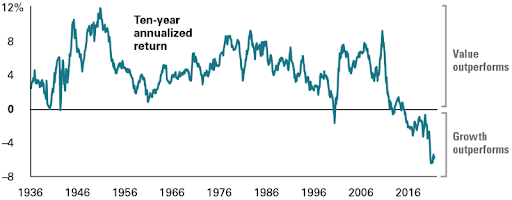The S&P 500 Index officially fell into a bear market in June 2022, after falling more than 20% from its highs. Rising inflation and political risk have many investors skittish on growth prospects, with Amazon, Alphabet, Tesla and other tech companies losing billions off their market cap. The good news is that there are a few safe havens for investors.
Let’s take a look at why value stocks are outperforming growth stocks in today’s market and some value-focused ETFs to consider.
See our Active ETFs Channel to learn more about this investment vehicle and its suitability for your portfolio.
Value vs. Growth
The S&P 500 Value Index Fund (VOOV) is down about 8% since the beginning of the year, but that’s far better than the S&P 500 Growth Index Fund’s (VOOG) nearly 18% drop and the S&P 500’s 14% drop. While a handful of individual sectors are performing even better – such as energy or commodities – value stocks have been the best high-level asset class.
Of course, these dynamics shouldn’t surprise anyone familiar with how stocks behave during an economic downturn. Value stocks have a built-in margin of safety thanks to their already-low valuations, whereas growth stocks have much further to fall, given their lofty valuations. In addition, value stocks rely less on outside funding to support their operations.

Source: Vanguard / Fama-French
A Vanguard analysis of 10-year annualized returns between 1936 and 2021 shows that value stocks have outperformed growth stocks throughout history. The asset manager reckons that the recent outperformance of growth stocks stems largely from low interest rates, which appear to be on their way out with recent rate hikes.
Best Value-oriented Active ETFs
Investors have more options than ever for investing in value stocks, given the rise in active ETFs. Moreover, with the U.S. potentially entering a bear market, there could be several new fund launches over the coming quarters as asset managers target a risk-averse audience and scale back their growth tilt.
Some of the top-performing value-oriented active ETFs this year include the following.
| Name | Ticker | AUM | Performance | Expense Ratio |
|---|---|---|---|---|
| American Century Large Cap Value ETF | FLV | $218 Million | -2.84% | 0.42% |
| WBI BullBear Value 3000 ETF | WBIF | $43 Million | -3.36% | 1.25% |
| JPMorgan Active VAlue ETF | JAVA | $54 Million | -3.40% | 0.44% |
| UVA Dividend Value ETF | UVDV | $17 Million | -4.40% | 0.80% |
Data as of August 4, 2022.
Investors should carefully consider the expense ratio and underlying strategies when choosing between funds. For example, when selecting value stocks, funds might employ various methods, such as looking at P/E ratios, P/B ratios, discounted cash flow analysis or a combination of these factors – and expense ratios can have a significant impact on returns.
The Bottom Line
The U.S. is in the midst of a bear market, which means value stocks could outperform. A Vanguard analysis suggests that the end of low-interest rates could help value stocks outperform over the long run. Fortunately, several ETFs and mutual funds provide exposure to value stocks, including actively-managed funds taking unique approaches.
Take a look at our recently launched Model Portfolios to see how you can rebalance your portfolio.





